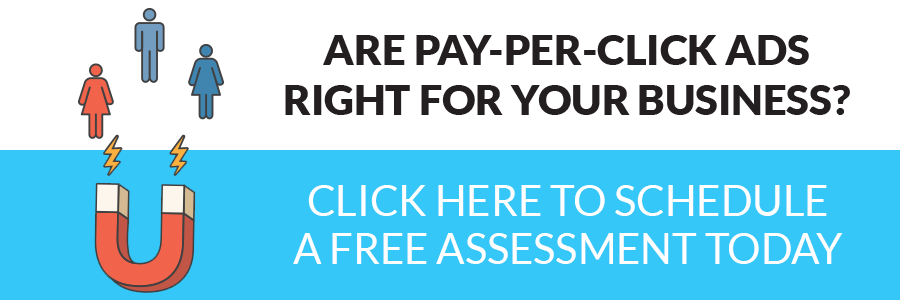Why B2B Companies Should Be Using Pay Per Click Marketing
The Role of PPC Ads in Business to Business Lead Generation
The way I look at ads is that they need to be part of your overall marketing strategy, but they can't be the entire strategy. Ads are great from the perspective of velocity. By that I mean, you could start running ads today and be getting leads tomorrow. So, they're a much faster way to start generating leads than traditional SEO or inbound marketing tactics which rely on your website's authority and your Google rankings to improve.
The problem with them is, though, that the ads ... You're generally going to have a higher cost per acquisition for each lead because you're paying per click. I like to think of PPC ads as a part of your overall digital marketing strategy, but it shouldn't be your entire strategy.
Watch the Recorded Webinar
Video Transcript
Hello, and welcome to the Marketing Peer Group series. In this edition, we're going to talk about creating quick wins without breaking the bank though Pay-Per-Click advertisement, or PPC.
So really, what the objective of today's session is, is to really review the common platforms that we can use for PPC advertisement in a business-to-business setting, and review how we can fit those particular platforms into the overall Buyer's Journey to generate new leads and opportunities for our businesses.
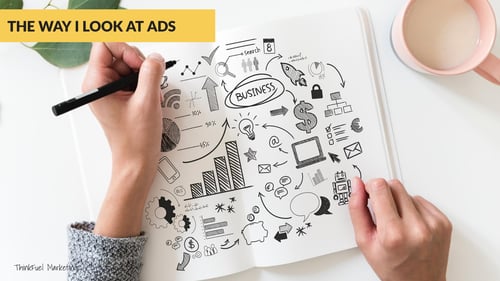 The way I look at ads is that they need to be part of your overall marketing strategy, but they can't be the entire strategy. Ads are great from the perspective that, really, you could start them today and be getting leads on your website tomorrow. So, they're a much faster way to start generating leads than traditional SEO or inbound marketing tactics that you've got to wait for your authority and your Google rankings and things like that to improve.
The way I look at ads is that they need to be part of your overall marketing strategy, but they can't be the entire strategy. Ads are great from the perspective that, really, you could start them today and be getting leads on your website tomorrow. So, they're a much faster way to start generating leads than traditional SEO or inbound marketing tactics that you've got to wait for your authority and your Google rankings and things like that to improve.
The problem with them is, though, that the ads ... You're generally going to have a higher cost per acquisition for each lead because you're paying per click, and so a very competitive market space. So I like to think of it as a part of the overall strategy. It's a good tactic early on in your digital marketing, because it can start getting leads that will help prove that this process works - but as well help fund future marketing activities like your SEO and your inbound side of things.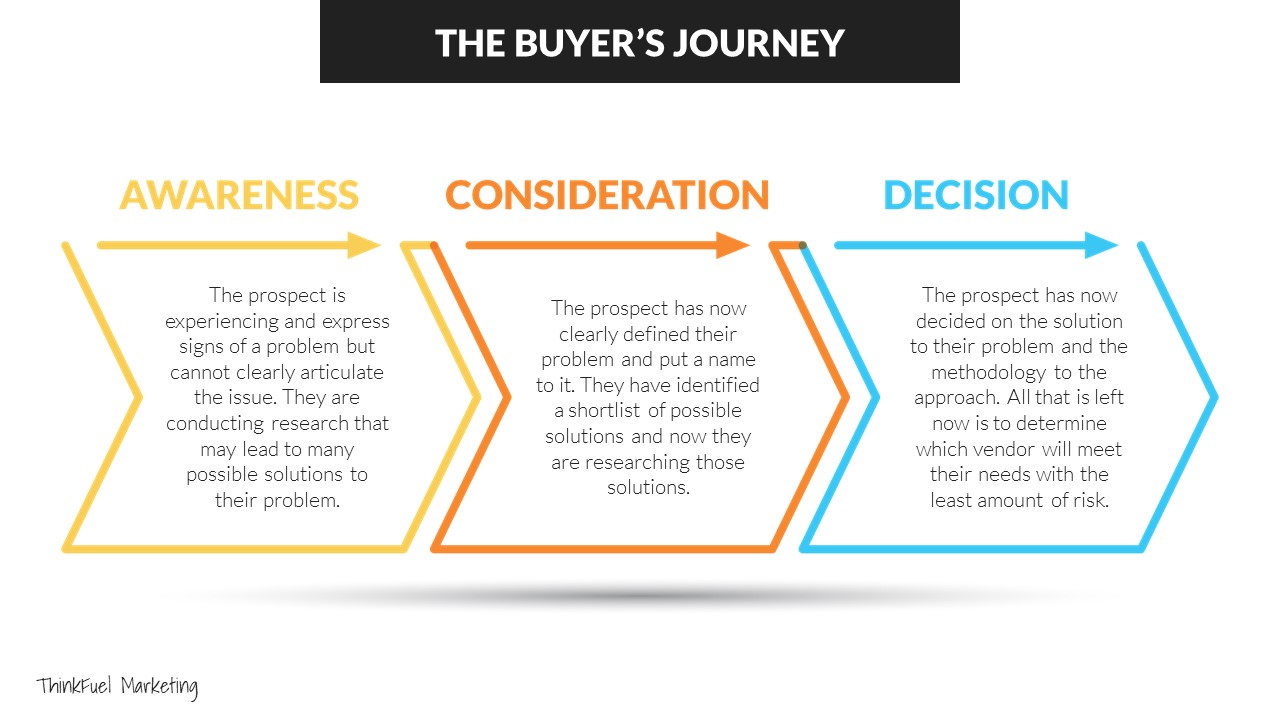
So before we jump into it too far, I want to review the Buyer's Journey again. Because like anything that we do - whether it's writing a blog, creating a new e-book, or in this case writing ads - we need to keep in mind the Buyer's Journey. So this, again, three stages to this: Awareness, Consideration, and Decision stage.
In the Awareness stage, this is really where the prospect is experiencing or expressing signs of a problem, but they can't clearly articulate what that problem is. They're conducting research, and it may lead to one of a whole bunch of different options, right? And one of those different options are ... They could be completely different from one another. So at the Awareness phase, we want to try to make them realize and help them understand what the challenge is.
In the Consideration phase, this is where they've given a name to their problem, and they've identified a shortlist of ways that they might want to fix it. So this is now where they're considering different types of solutions, but they've narrowed that list of solutions down to a handful of them. So now they're investigating because your solution - Is it going to be the best one for me?
In Decision phase, this is where they've decided on how they want to fix their problem and the methodology of how they're going to approach it. All that they have to do now is start interacting with vendors. They're going to create a shortlist and then work through that to decide who is going to help them solve their issue with the least amount of risk.
So, now let's talk quickly about common platforms for doing paid advertisements that we see used in the business-to-business environment.
The first one is Google Ads. It's what used to be called Google AdWords. They shortened it last year to just Google Ads, and there's three main types. I mean, there's a lot of different variations and ways you can use Ads, but they really fall into three main categories:
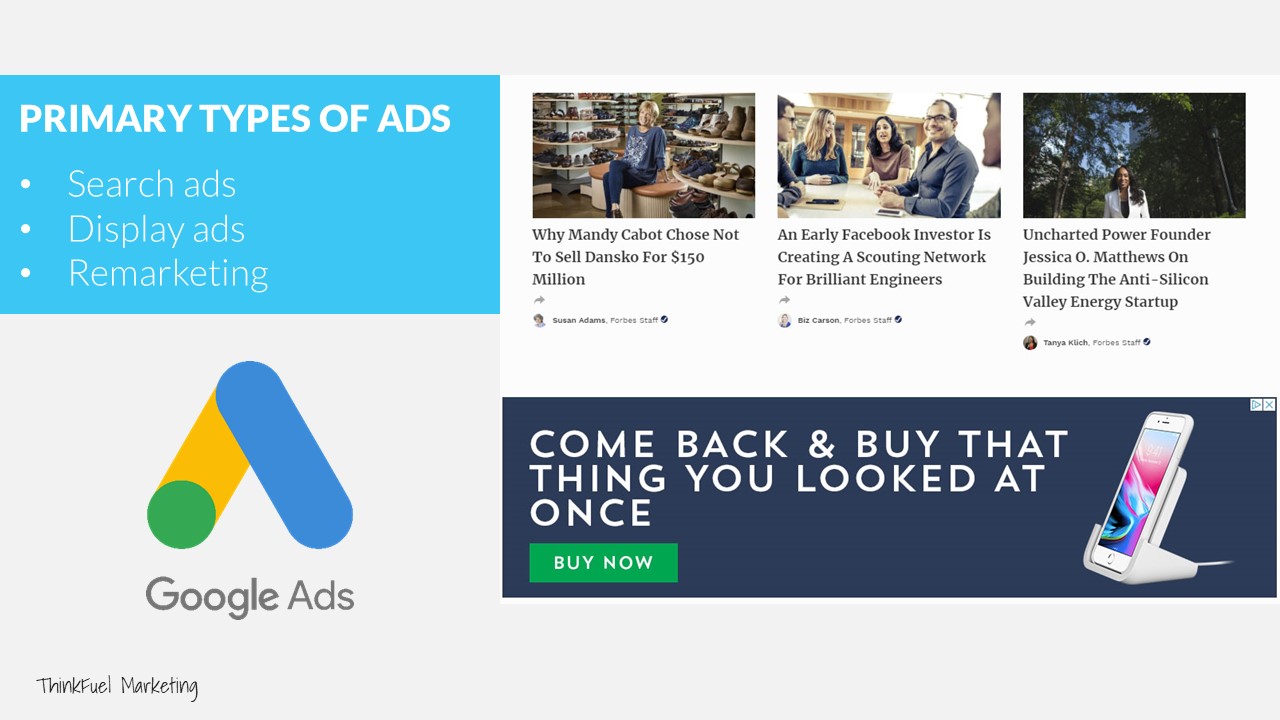
The first one is a search ad, so the ones that you're used to seeing when you run a search for almost anything on Google these days - where you'll actually see right in them ... It will say "ad" right beside the URL, and there are usually a handful of ads at the top and the bottom of every search page.
The next ones are what we call "display ads," where you see graphical ads beside news articles, blogs, other websites, things like that, that are related to the topic that you're reading about at that time.
And then the last one is remarketing, all right? And these are the ones that are the kind of creepy ads that follow you around everywhere. So, it's when somebody's come to your website, we've put cookie on their browser, and we begin following them around, showing them ads throughout Google's display network. So these are the ones that you see from places like Amazon and Home Depot, where you looked at a product on there once, and all of a sudden for the next 30 days you see an ad saying, "Hey, come back and grab these."
So these are the most common types of ads that we see people running on the Google Ads platform. So, when should we use Google Ads? Well, really the primary area to use them is when people are in that Decision phase. People who click on ads, particularly the search ads, are usually at the point where they're going to say, "I need to invest in this. I want to buy this." So, they're at that Decision stage.
Secondarily, you might want to use it in the Consideration phase. This is when we're trying to figure out if my solution is the best for them, and that's where we find a lot of the remarketing and display ads come in - because what they do is they follow people around and they bring that visual back into the process when people are on different sites. So, they help keep you top of mind, and keep your solution top of mind.
Let's talk a little bit about LinkedIn ads. And again, there's three primary types that you'll see on LinkedIn. The first one is sponsored content, so that's when you see an ad come up in your news feed on LinkedIn. A lot of the times you might not even recognize it as an ad, but they're paid content that goes out to the people.
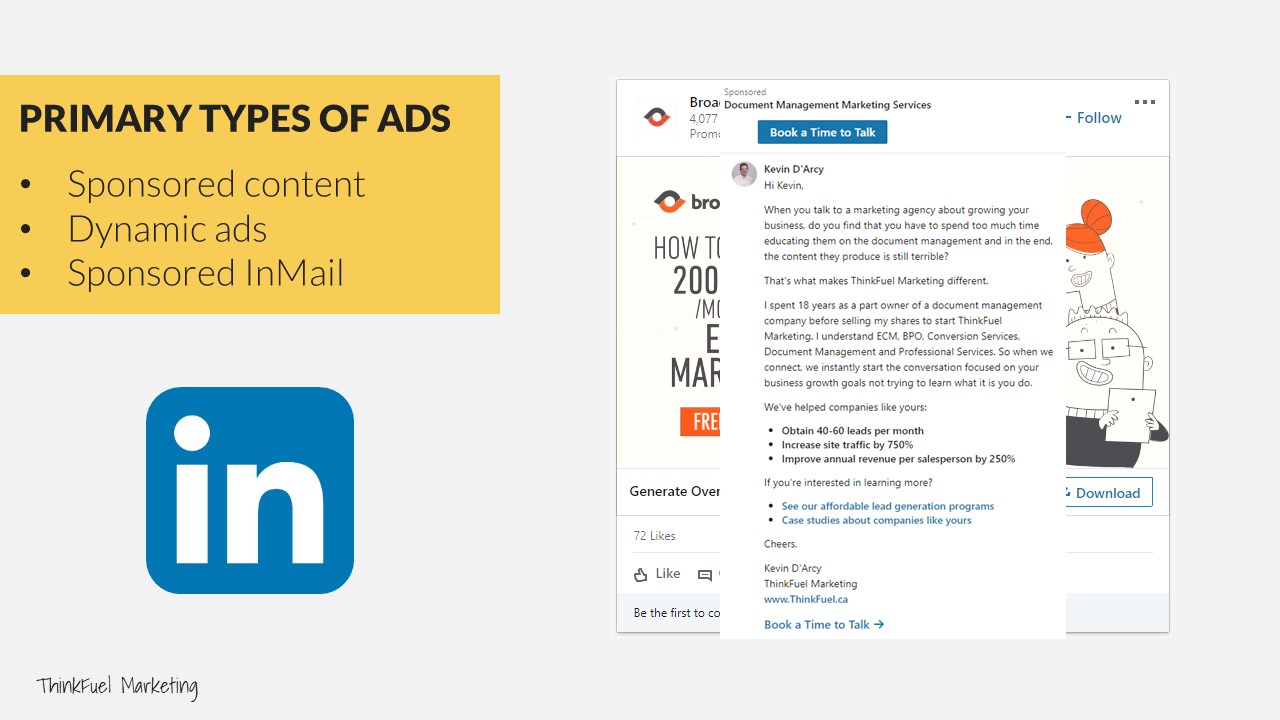
Then we have dynamic ads, and these are the ones where you see a picture of yourself or your company's logo, and the person running the ad - something like what you see here on the screen. You see a lot of this around recruitment and HR type applications.
And then you have sponsored InMail. And sponsored InMail is just the ability to send the LinkedIn InMail messages through their platform to your target audience. So you can write up whatever you want, define your audience type, and it will just start sending those out based on your budget and your availability.
So, when do you use LinkedIn ads? Really, you can use them at all the different stages. Because LinkedIn, because their platform offers a lot of different variations of how you can get that ad in front of people, but also because of the really tight targeting you can do on LinkedIn. You can really start to try to push and show people ads at any of the three stages of the Buyer's Journey.
So, Facebook Messenger and Instagram ads - you typically see a lot more of these in the business-to-consumer space, rather than business-to-business. But we have seen some success around these as well. Again, so there's three primary types of ads that you'll see on there, and they're just videos, photos, and carousels. Photos are these kind of one-off images that you'll see, like this. Then you'll get the carousel style, where you can scroll through a variety of different images. And of course, because all the platforms are owned by the same brand, you can do the same advertisement on Instagram as well.
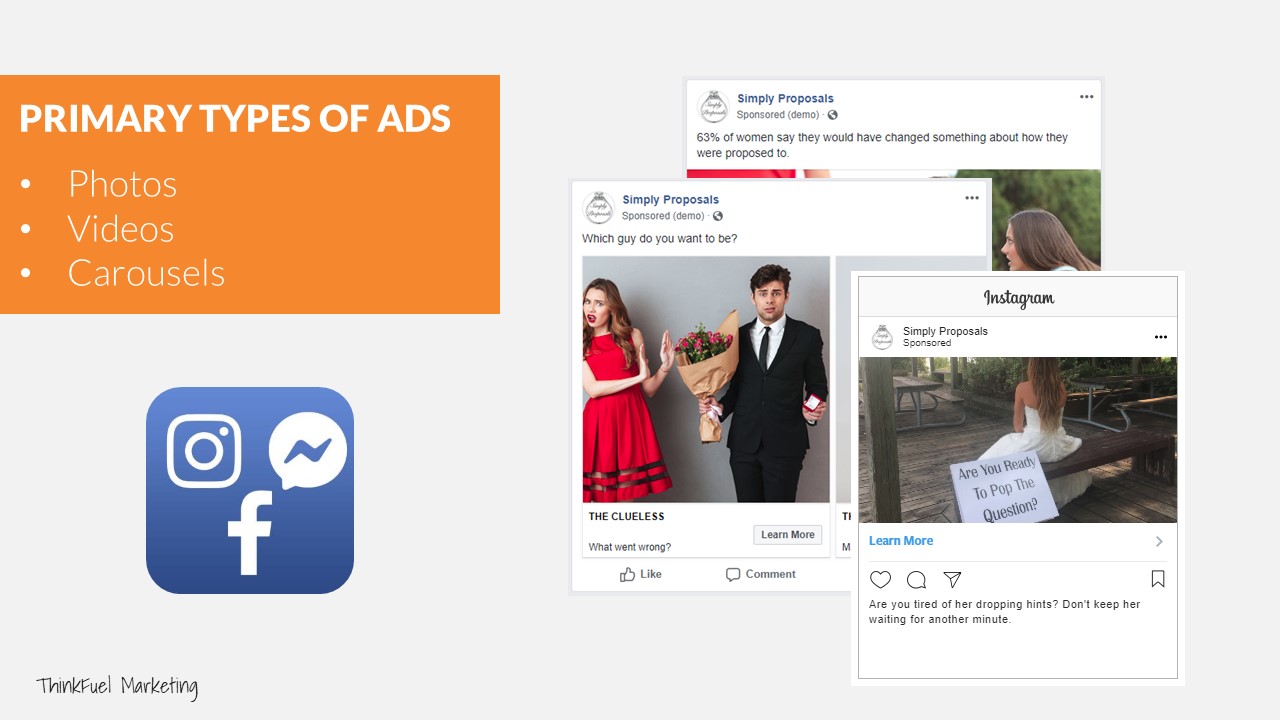
The nice thing with Facebook is, again, you've got a really very in tune targeting system, so you can really target the right audience members. But the reason it's a little bit of a challenge for B2B is that most people who are on these platforms aren't really on business mindset. This is more of a personal space for them. So, you'll see a lot more business-to-consumer type ads, as compared to business-to-business on here. But where it can actually be a useful one, is using like the Geo-Fencing, which is essentially, "I just want to show ads to my audience in this very specific area."
So we see a lot of businesses targeting conventions or trade show events where their target audience is going to be - and especially if they are multi-day events. Because, you know, I have a booth down in the vendors' area, and my target audience is walking through. But then at night, they're going to go back up to their hotel room, probably check their Facebook, and they're still in that quasi-business mode because they're at a conference, they're away from home. And they're going to see my ads telling them to come down and visit my booth. Right? So that's one of the areas that we see a lot of B2B ads, on the Facebook platform.
And so, the slide says, "LinkedIn Ads." It should say, "Facebook Ads." But, when to use them is primarily at the Decision phase. So again, when people are ready to buy or invest. And the Consideration phase, when we're trying to raise awareness for the solution that we deliver.
Quora ads. This is a new one for a lot of people, I think, and it's one that I think is a really great platform for B2B. There's really just the one primary ad type when you come into Quora, and that is a text or questions. What they look like is things like these ones here, right? So if you're not familiar with the Quora platform itself, it's basically a question-and-answer platform. You'll have people on there asking about any imaginable topic, or interest, or anything like that: things from, "How can I sell more? How can I fix a car?" Everything like that.
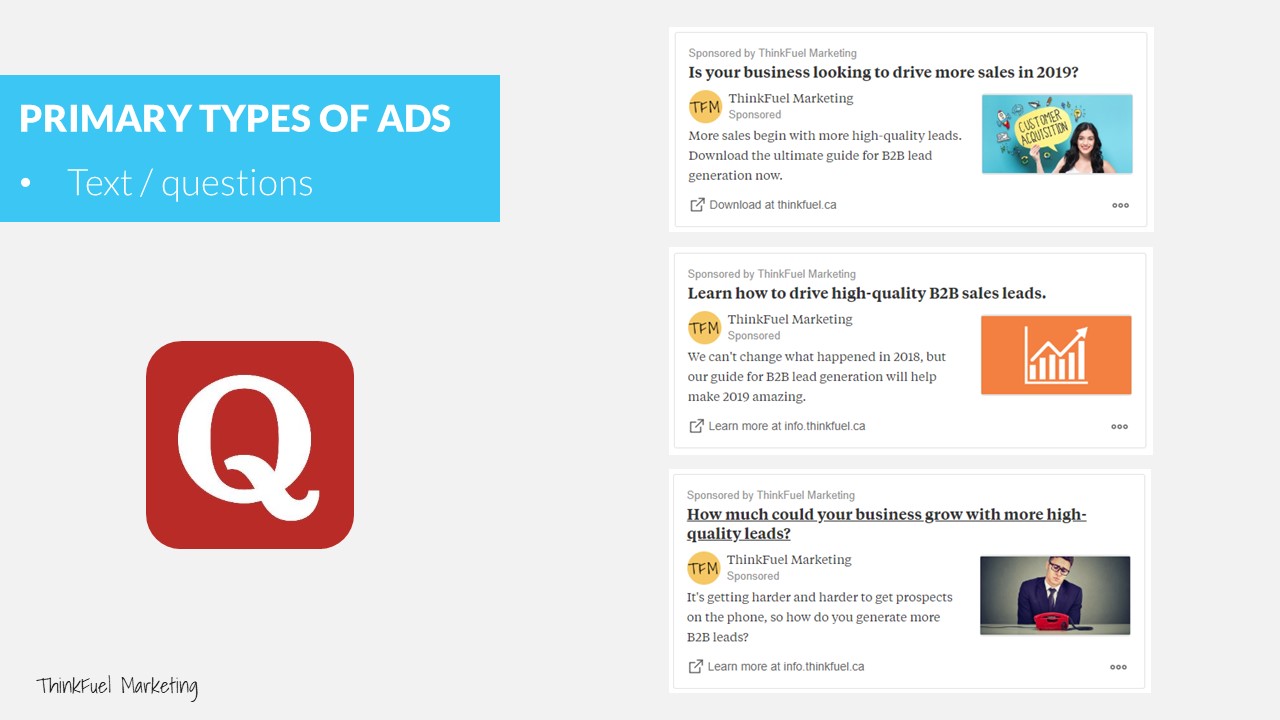
So what you can do is you can get very aggressive, again, with the targeting. You can target on the specific topics that your industry focuses on, and you can form all of these as a question, so it helps to really instigate click-throughs and things like that. So, it's a very helpful, very powerful platform. It's new to a lot of people, so it's rather inexpensive right now. It's definitely something that you might want to check out, as well.
When can you use Quora ads? Really, I would suggest at the Awareness and the Consideration stage. People, when they're in Quora, they're researching, right, so that ties in perfectly with the Awareness and Consideration phases. They're not typically in that buying mentality, so they're probably not going to come through and purchase something right away, or sign up to get a quote or a free assessment, or things like that. But if you have an ebook that helps them with a particular issue, they're probably going to come to your site and download, and then you can add them to your nurture process.
That about wraps up the quick review of different PPC platforms and how we tie those into the Buyer's Journey. So, a couple of key elements that we want you to remember as you walk away, is that ads are a great tool for quick wins. Like we said, you could turn them on today, start getting leads tomorrow. They should be part of your overall digital marketing strategy, but they shouldn't be the only part of your digital marketing strategy.
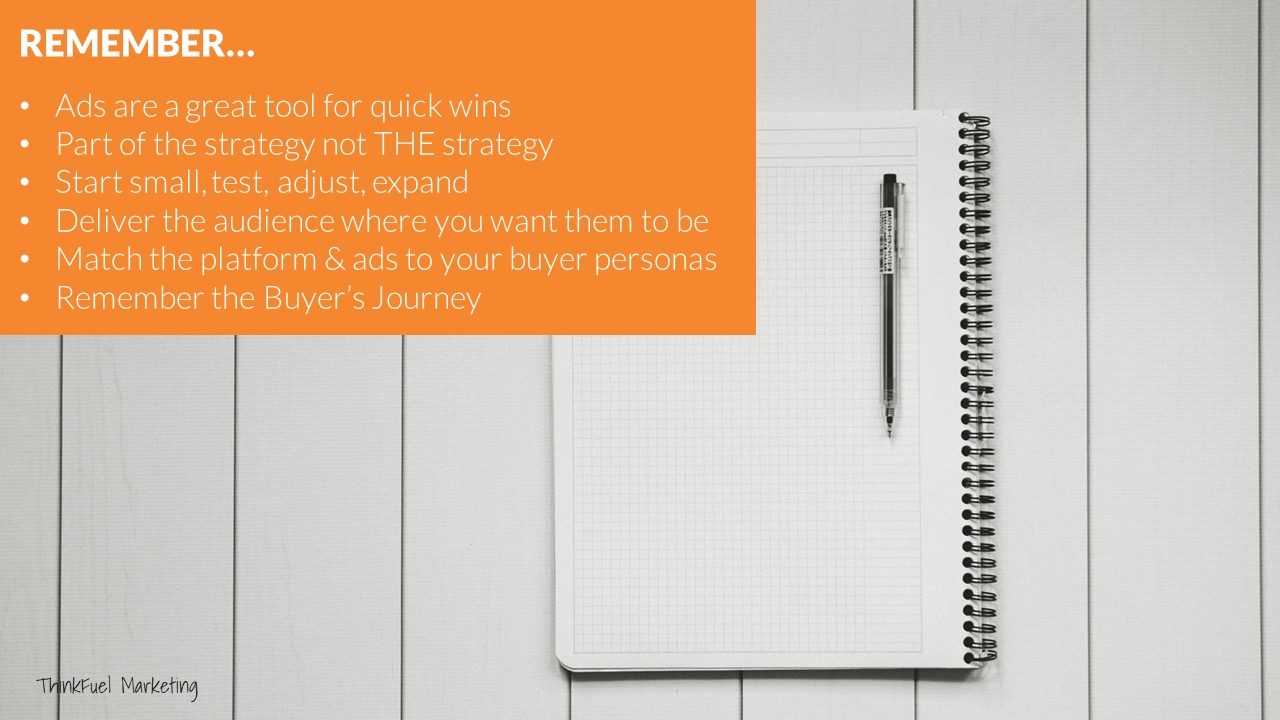
Start small, test, adjust, and expand. What we mean by that is that these platforms, it's very easy to spend a lot of money if you're not really tightly controlling your audience, your budget, your cost-per-click, things like that. So start small, see what's working, and then start to expand your audience or your budget or both. But don't just say, "Hey, let's spend $2000.00 a month and target everybody who is on LinkedIn." You're not going to get great results from that.
Deliver the audience where you want them to be. What we mean by that is, any of these ads should take people to a landing page that is specific to what the ad content was about. So, if we have an ad content that says, "Get this free e-book on 12 Ways to Generate More Leads For Your Website," I shouldn't bring them to the contact desk page, I should bring them to a landing page where they can fill out a form and get that e-book.
What we want to also do is match the platform that we're going to use - whether it's Google, LinkedIn, Quora, you name it - to the buyer's persona. Everything's got to be at the heart of the buyer persona that we're doing. And remember the Buyer's Journey. Always keep that in mind, always keep that in the forefront of your head when you're creating new content, new ads, anything online. Ads are no different than when you're writing blogs, or e-books, or whatever. Always remember the Buyer's Journey.
So, I hope you found this helpful. If you have any questions, feel free to reach out to us and you can use the link below to download a copy of the slides as well.
Table of contents
Share this
You May Also Like
These Related Stories
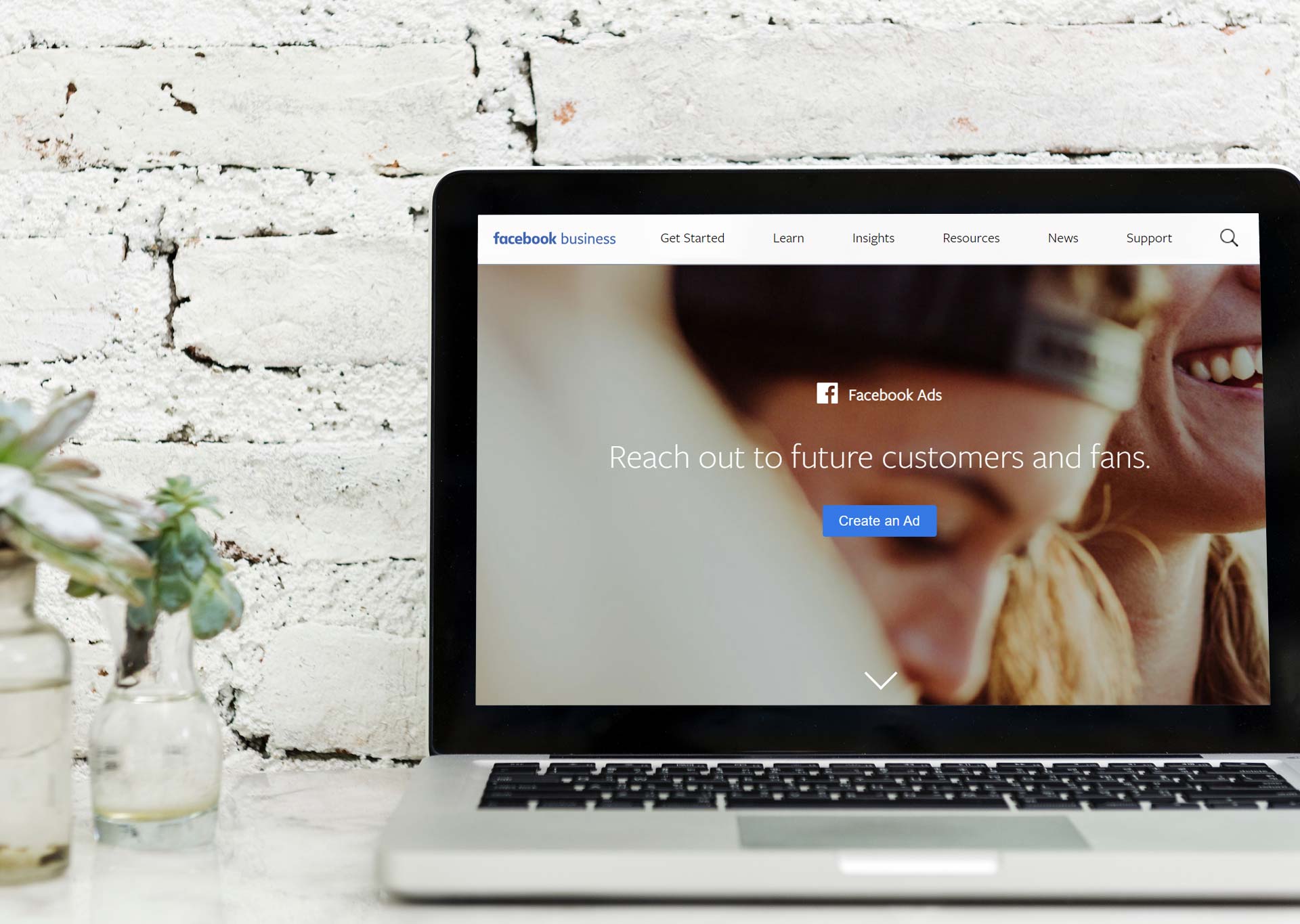
How to Run a Successful B2B Facebook Ads Campaign
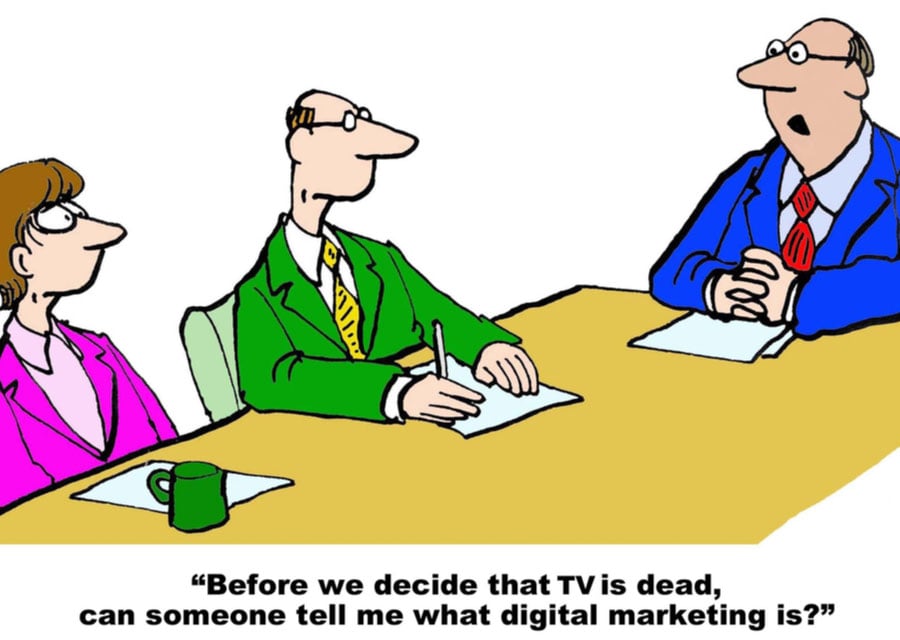
A B2B Guide on How to Grow Your Business Through Digital Marketing



